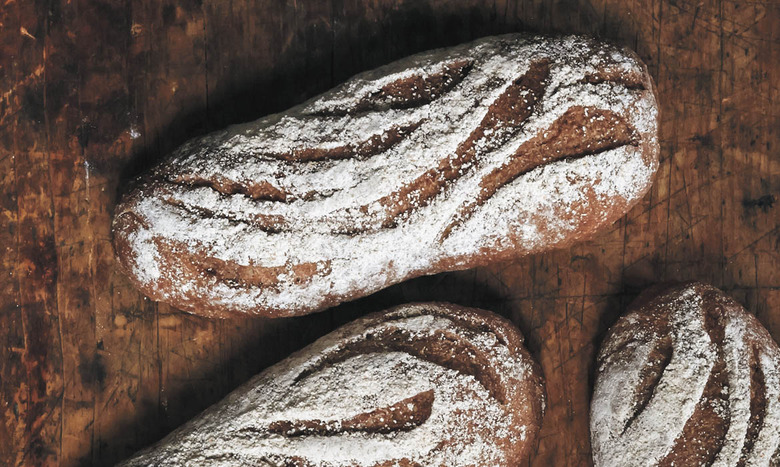Rich Pumpernickel With Toasted Grains
Rich Pumpernickel With Toasted Grains
An addition of toasted pumpernickel flour is enhanced by both molasses and cocoa, taking the foundation of the German rye three steps further. The very slight chocolate overtones and the sweetness from the molasses partner well with these grains, though the dough will be sticky to work with.Excerpted from One Dough, Ten Breads, © 2016 by Sarah Black. Reproduced by permission of Houghton Mifflin Harcourt. All rights reserved.
Servings
8

Ingredients
- 6 ounce pumpernickel flour
- 1 1/2 teaspoon active dry yeast
- 2 teaspoon table salt
- 1/4 ounce unsweetened cocoa powder
- 1 3/4 ounce warm water
- 8 ounce unbleached bread flour
- 4 ounce whole wheat flour
- 9 ounce cool water
- 2 ounce molasses
- vegetable oil, as needed
Directions
- Measure and weigh the yeast, salt, and cocoa powder separately and set them aside.
- Weigh the warm water into a small bowl. The warm water should feel hot to the touch, between 105 degrees and 115 degrees F. Sprinkle the yeast on top of the water, stir to dissolve, and set aside.
- Weigh the bread flour and whole wheat flour, and combine in a large mixing bowl with the 4 ounces toasted pumpernickel flour. Sprinkle the cocoa powder and salt on top of the flour, stir to incorporate, and then make a well in the center.
- Weigh the cool water into a small bowl, then the molasses into another small bowl. The cool water temperature should be between 70 degrees and 75 degrees F.
- Add the yeast mixture to the flour mixture, stir 3 or 4 turns, and then, little by little, add the cool water. Mix with your hands for 2 to 3 minutes, and then add the molasses. Continue mixing until all of the ingredients are incorporated, the grit of the salt is dissolved, and the dough forms a rough and shaggy mass, and then stop.
- Cover the bowl with a kitchen towel or plastic wrap and let the dough stand still for about 30 minutes.
- Sprinkle your work surface with flour and then use a plastic bowl scraper to scrape the dough out onto it. Tap your hands in a little flour, then gently flatten the dough into a rectangle, with the short side facing you.
- Use your fingers or the plastic scraper to flip the top edge of the dough down to just below the center, then flip the bottom edge up to just above the center. Repeat this process for the right and left sides, then turn the dough over and dust off the flour.
- Oil a second large bowl, then place the dough in it, seam side up, to oil the top. Then turn it seam side down, and cover the bowl with oiled plastic wrap. Mark the time with a felt-tipped pen on the plastic wrap and allow the dough to rest and rise in a moderately cool place until it has doubled in volume, 1 to 2 hours, depending on the heat of your environment.
- After the first 30 minutes of fermentation, turn the dough out of the bowl onto your work surface, and fold again as described on the previous page. Return the dough to the bowl, cover, and complete the fermentation.
- Sarah’s Note: Because pumpernickel flour is low in protein, this dough benefits from additional folding, which develops strength.
- Once the dough has doubled in volume, sprinkle a little more flour onto your work surface, then scrape the dough out onto it, letting the dough assume its natural shape. Dust the top of the dough with a little flour and pat it down gently. Divide the dough into 4 equal pieces, and then pre-shape them into logs. Let the dough rest for about 10 minutes, and then shape the logs into batards.
- To proof the mini batards, take a kitchen towel about the size of your baking sheet, and place it on top of the baking sheet. Tuck the left edge of the towel under itself, then sprinkle the entire towel heavily with flour. Place the first batard, seam side down, on top of the towel at the very left end and the second batard below it. Pull the towel on the right toward the batard to form a loop up against the dough. Place the third and fourth batards on the towel next to the first two, and pull the towel to make another loop. Finish by tucking the right-hand edge of the towel under itself. Cover with oiled plastic wrap and let the batards proof until the dough has doubled in volume, 30 to 40 minutes.
- While the shaped dough is proofing, preheat the oven to 480 degrees F, with an empty pan for creating steam on the bottom of the oven. Have ready a spritzer filled with water near the oven and approximately 8 ounces of hot water to pour into the empty pan in the oven to create steam.
- Once the batards have approximately doubled in volume, transfer them to a baking sheet. Dust a little of the reserved toasted pumpernickel flour on top for a decorative look and smooth the flour gently with your hand. Dip a lame or straightedge razor in water, and score with curved lines as pictured.
- Open the oven door, slide the baking sheet with the batards onto the middle rack, and pour the hot water into the empty pan below to create steam before quickly closing the oven door. After 1 minute, open the oven door and spritz around the batards, then close the door.
- The mini batards should bake in 30 to 35 minutes.
- Let the batards cool completely on a wire rack.